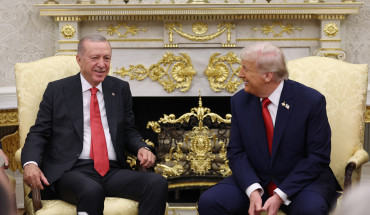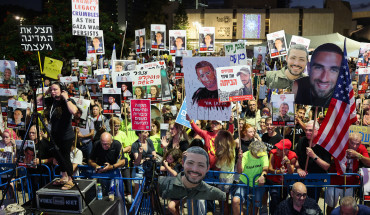The last five years of the Israeli-Palestinian conflict could be summed up in one word: Gaza.
Israel’s lethal raid on the flotilla attempting to deliver aid to Gaza is part of a recurring theme that goes like this: Gaza wallows in dysfunction. Tensions steadily build. A confrontation erupts. Every major crisis between the Israelis and the Palestinians in recent years has revolved around Gaza—the overcrowded, impoverished strip of sand squeezed between Israel and the Mediterranean.
When former Israeli Prime Minister Ariel Sharon pulled all Israeli soldiers and settlers out of Gaza in the summer of 2005, his hope—shared by a large majority of Israelis—was that Israel could wash its hands of Gaza once and for all.
Even Sharon, Israel’s most prominent hawk and its most determined builder of Jewish settlements, came to accept that an Israeli presence in Gaza was an enormous liability that was only becoming more burdensome with each passing year.
When the last Israeli tank rumbled out of Gaza, it seemed plausible that Gaza might quietly go about the business of healing itself and the focus of the conflict would be between Israel and the West Bank.
Instead, the opposite has happened. Israel’s suffocating blockade, Palestinian infighting and a general indifference from the international community have helped make Gaza the most combustible part of the Israeli-Palestinian conflict.
In June 2006, less than a year after the Israelis left Gaza, Palestinian militants dug a tunnel into Israel, killing two Israeli soldiers and seizing a third. The captured solider, Gilad Shalit, is still being held and his case remains a major source of friction.
In 2007, the radical Islamist group Hamas fought the rival group Fatah in a week of nasty street battles that culminated with Hamas taking full control of Gaza. Israel responded with its blockade of the territory.
In December 2008 and January 2009, Israel unleashed a ferocious three-week offensive in response to years of Palestinian rocket fire coming out of Gaza. The operation killed well over 1,000 Palestinians and inflicted great damage.
And now we have the Israeli commando raid of the aid flotilla in the Mediterranean.
It’s challenging to find a silver lining in the dark clouds that permanently hang over Gaza. However, the repeated crises do draw attention to Gaza’s plight and create opportunities to address the disastrous conditions there. In recent years, these opportunities were ignored. This time there appears to be greater international interest in reassessing Israel’s blockade of Gaza.
Israel’s blockade has two main goals: punish Hamas, which still runs the territory, and guard against the import of weapons.
The strategy has not worked particularly well on either front. Hamas is more entrenched than ever and there is no sign that the group is likely to be ousted. Meanwhile, Palestinians have no trouble smuggling weapons through tunnels that run beneath Gaza’s southern border with Egypt.
Israel permits essential goods into Gaza, including food, fuel and medicine. Little else can be sent there, however. Gaza’s 1.5 million people are not starving, but there is no prospect of living a normal life. The territory is so small and lacking in resources that it is utterly dependent on links to the outside world. Israel has barred even basic items like cement, which is in huge demand. Israel asserts that cement and other building materials could be used to establish defensive positions or make weaponry.
Gaza never had much of an economy to begin with, but even that has effectively withered away. Palestinian businessmen in Gaza have found it impossible to import or export goods with any reliability. Gaza factories that produced furniture and textiles for the Israeli market have shut down.
Israel does have serious security concerns in Gaza. The Palestinians have fired more than 12,000 rockets out of Gaza over the past decade. The shooting has largely stopped for now, but the Palestinians have the means to resume the attacks. The smuggling through the tunnels is the greatest concern, but the Palestinians have also tried to import weapons by sea. Back in 2002, Israel seized a cargo ship, the Karine A, carrying tons of weapons bound for Gaza.
Perhaps the greatest obstacle to improving conditions in Gaza is the lack of a communication channel between Israel and Hamas. Israel says Hamas is a terror organization and refuses to talk to the Islamist group. Hamas refuses to recognize Israel and also rejects any talks with the Jewish state.
No one is expecting Israel and Hamas to hold direct talks. There is no prospect of peace between the bitter enemies. Yet even if Gaza’s problems cannot be solved, they do need to be managed. Egypt has served as a mediator in the past, and could potentially fill that role again. If Gaza’s problems are not addressed now, it is only a matter of time before the next Israeli-Palestinian crisis erupts there.
Assertions and opinions in this Policy Insight are solely those of the above-mentioned author(s) and do not necessarily reflect the views of the Middle East Institute, which expressly does not take positions on Middle East policy.
The Middle East Institute (MEI) is an independent, non-partisan, non-for-profit, educational organization. It does not engage in advocacy and its scholars’ opinions are their own. MEI welcomes financial donations, but retains sole editorial control over its work and its publications reflect only the authors’ views. For a listing of MEI donors, please click here.













